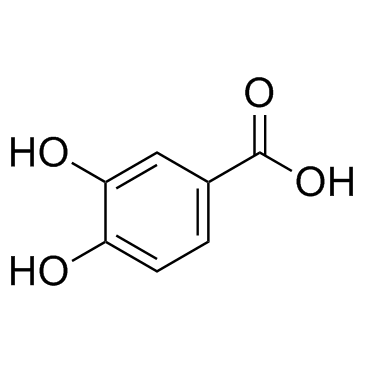

原儿茶酸结构式

|
常用名 | 原儿茶酸 | 英文名 | protocatechuic acid |
|---|---|---|---|---|
| CAS号 | 99-50-3 | 分子量 | 154.120 | |
| 密度 | 1.6±0.1 g/cm3 | 沸点 | 410.7±35.0 °C at 760 mmHg | |
| 分子式 | C7H6O4 | 熔点 | 197-200 °C (dec.)(lit.) | |
| MSDS | 中文版 美版 | 闪点 | 216.3±22.4 °C | |
| 符号 |

GHS07 |
信号词 | Warning |
|
Antimicrobial activity of natural products from the flora of Northern Ontario, Canada.
Pharm. Biol. 53(6) , 800-6, (2015) The number of multidrug resistant (MDR) microorganisms is increasing and the antimicrobial resistance expressed by these pathogens is generating a rising global health crisis. In fact, there are only a few antimicrobial agents left that can be used against MD... |
|
|
Antioxidant activity of protocatechuates evaluated by DPPH, ORAC, and CAT methods.
Food Chem. 194 , 749-57, (2015) Hibiscus sabdariffa L. is a worldwide consumed plant, principally after infusion of its dried sepals and calyces, which are usually discarded. Nevertheless, they represent a potential source of natural bioactive compounds, e.g. polyphenols, which could add va... |
|
|
Effect of selected Saccharomyces cerevisiae yeast strains and different aging techniques on the polysaccharide and polyphenolic composition and sensorial characteristics of Cabernet Sauvignon red wines.
J. Sci. Food Agric. 95 , 2132-44, (2015) The objective of this work was to study the effect of two Saccharomyces cerevisiae yeast strains with different capabilities of polysaccharide liberation during alcoholic fermentation in addition to subsequent aging on lees with or without oak wood chips as w... |
|
|
[Chemical constituents from Commelina communis].
Zhongguo Zhong Yao Za Zhi 38(19) , 3304-8, (2013) To investigate the chemical constituents from Commelina communis, fifteen compounds were separated and purified by silica gel, Sephadex LH-20, and ODS column chromatography, and semi-preparative HPLC. By analyses of NMR and MS data as well as their physical a... |
|
|
Arhodomonas sp. strain Seminole and its genetic potential to degrade aromatic compounds under high-salinity conditions.
Appl. Environ. Microbiol. 80(21) , 6664-76, (2014) Arhodomonas sp. strain Seminole was isolated from a crude oil-impacted brine soil and shown to degrade benzene, toluene, phenol, 4-hydroxybenzoic acid (4-HBA), protocatechuic acid (PCA), and phenylacetic acid (PAA) as the sole sources of carbon at high salini... |
|
|
Antagonistic control of a dual-input mammalian gene switch by food additives.
Nucleic Acids Res. 42(14) , e116, (2014) Synthetic biology has significantly advanced the design of mammalian trigger-inducible transgene-control devices that are able to programme complex cellular behaviour. Fruit-based benzoate derivatives licensed as food additives, such as flavours (e.g. vanilla... |
|
|
Synthesis and accumulation of aromatic aldehydes in an engineered strain of Escherichia coli.
J. Am. Chem. Soc. 136(33) , 11644-54, (2014) Aromatic aldehydes are useful in numerous applications, especially as flavors, fragrances, and pharmaceutical precursors. However, microbial synthesis of aldehydes is hindered by rapid, endogenous, and redundant conversion of aldehydes to their corresponding ... |
|
|
DNA-Linked Enzyme-Coupled Assay for Probing Glucosyltransferase Specificity.
ACS Synth. Biol. 4 , 833-41, (2015) Traditional enzyme characterization methods are low-throughput and therefore limit engineering efforts in synthetic biology and biotechnology. Here, we propose a DNA-linked enzyme-coupled assay (DLEnCA) to monitor enzyme reactions in a high-throughput manner.... |
|
|
Analysis of different European hazelnut (Corylus avellana L.) cultivars: authentication, phenotypic features, and phenolic profiles.
J. Agric. Food Chem. 62(26) , 6236-46, (2014) Hazelnuts exhibit functional properties due to their content in fatty acids and phenolic compounds that could positively affect human health. The food industry requires precise traits for morphological, chemical, and physical kernel features so that some cult... |
|
|
Investigating the potential of under-utilised plants from the Asteraceae family as a source of natural antimicrobial and antioxidant extracts.
Food Chem. 161 , 79-86, (2014) Antimicrobial properties of ethanol and water extracts from eight Asteraceae species were investigated against three Gram positive (Staphylococcus aureus, MRSA and Bacillus cereus) and two Gram negative (Escherichia coli and Salmonella typhimurium) bacterial ... |